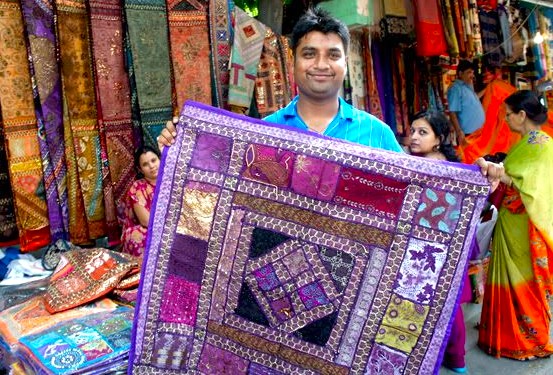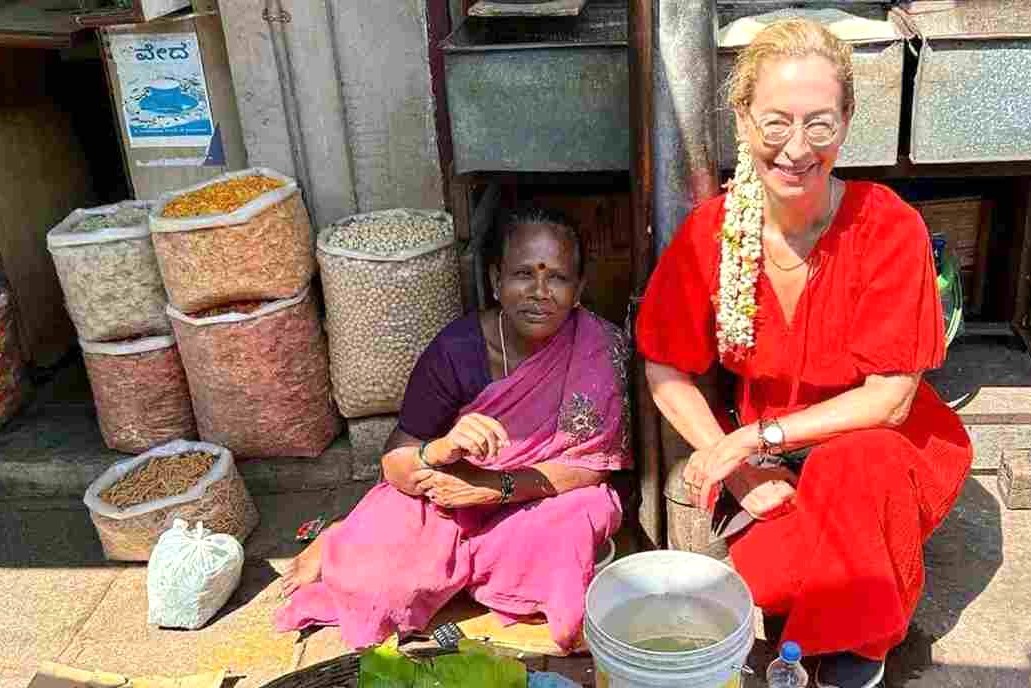Spirit of India
Devaraja Market: Mysore
Discover Life Travel
Tradition Meets Trade: Devaraja Market Mysore
Devaraja Market Mysore. One of India’s most lively and historic marketplaces, where tradition and commerce come alive amongst a rich tapestry of colors, fragrances, and sounds. Located in the heart of Mysore, this market has been an essential part of the city’s social and economic landscape for over a century. The word “Devaraja” comes from Mysore's revered Wodeyar Dynasty, under whose reign this market came into prominence. It translates to “King of Gods,” epitomizing its importance to both the common people and the royals. Built in the 1880s, Devaraja Market stands as a living relic of Mysore’s mercantile history. Its busy shops house everything from fresh produce and fragrant flowers to spices, Mysore incense, and silk. While it caters to the everyday needs of locals, the market is also an iconic destination for those seeking to experience the city’s authentic culture.

Origins of a Living Legacy
Devaraja Market Mysore. The market traces its roots back to the royal era of the Wodeyar Kings, who ruled Mysore from the 14th century. Officially established in the 1880s, the market evolved from a small bazaar designed to supply goods to the palace and the surrounding city. Over time, it expanded into a sprawling space accommodating hundreds of traders, artisans, and vendors. Its name pays homage to King Dodda Devaraja Wodeyar, of the Wodeyar Dynasty, who promoted the region’s trade and agricultural wealth. The strategic location of Mysore as a center of power ensured the market’s steady growth, transforming it into an essential hub for trade during the height of the kingdom's prosperity.
Streets of Trade: Devaraja Market Mysore
The layout of is a perfect blend of functionality and tradition. Comprising two main sections intersected by bustling lanes, the market features over 800 stalls arranged in neat rows, each specializing in a specific category of goods. Vendors display their wares in temporary wooden carts or under canvas tents, their vibrant arrangements vying for attention. The flower market is renowned for its heaps of marigolds, jasmine, and roses, meticulously strung into garlands for temple offerings or celebrations. Moving deeper into the market, one finds spices, fresh vegetables, fruits, and incense sticks, all contributing to the kaleidoscope of activity that defines this commercial place.
Treasures in Spices

Devaraja Market Mysore. The spice section of the market truly delights the senses, with vendors presenting brilliantly colored powders and aromatic dried herbs in neatly arranged woven baskets. Turmeric, cardamom, and cloves are plentiful, each evoking Mysore’s longstanding and vital role in the historic spice trade. Vendors take pride in their meticulous displays, creating a visual tapestry that draws shoppers from near and far. Of particular note are the fiery Byadgi chillies, which not only bring distinctive flavor to local cuisine but also stand as a symbol of the rich agricultural traditions and rural abundance found throughout the Mysore region. The market becomes a celebration of spice culture, welcoming cooks, traders, and curious visitors into its vibrant heart daily.
Blossoms for the Gods
The flower section of Devaraja is among its most intriquing areas, where garland makers work tirelessly to weave flowers into intricate arrangements. Flowers such as jasmine, lotus, roses, and chrysanthemums are sold in large quantities, with their intoxicating fragrance permeating the air. These blooms hold significant cultural and religious value, as they are often used as offerings in Mysore’s many temples, including the iconic Chamundeshwari Temple. The garlands can be customized for weddings, festivals, or sacred rituals, making this segment of the market integral to the city’s spiritual identity.
The Essence of Incense

Skilled artisans produce some of the city’s most desired agarbattis, or incense sticks, using natural ingredients like sandalwood powder, floral oils, and resins. Mysore’s renowned sandalwood is carved into incense that gently burns with a soothing, aromatic smoke, reflecting the enduring spirit of the city. These incense sticks are sought not just for religious rituals but also as symbols of Mysore’s deep connection to its natural resources and local craftsmanship. Shopfronts feature rows of colorful incense packets, while vendors blend and grind ingredients to craft unique, custom fragrances for us. Mysore incense is world reknowned and consumers travel from everywhere for this incense. We enjoy rolling owe own during the evening, most enjoyable.
Sweet Traditions
A trip is incomplete without exploring its sweet offerings. Mysore Pak, the melt-in-the-mouth dessert believed to have been created in the Wodeyar Royal kitchens, is a local specialty found in many stalls inside the market. Made from gram flour, ghee, and sugar, this iconic sweet is often sold in blocks wrapped in parchment. It is not just a delicacy but a cultural symbol of Mysore’s culinary heritage, representing the indulgence and perfection associated with royal kitchens.
Festivals and Feasts
The market comes alive during Mysore’s famous Dasara festival, celebrated in September or October. Dasara is a ten-day event that transforms Mysore into a vibrant space of celebration, and the market becomes its pulsating heart. Vendors increase their stock of flowers, spices, and festival essentials while the market buzzes with energy as locals prepare for the grandeur of the royal processions and temple rituals. The market also witnesses a surge in demand for silk sarees, traditional snacks, and locally crafted decorations, making it an inseparable part of the city’s festive spirit.
Ancient Trade Routes

Mysore played a key role as a crucial connector within South India’s historical trade routes, linking major coastal ports to flourishing inland markets. The city’s market prospered as a result, trafficking in goods such as sandalwood, luxurious silk, and renowned spices, all of which traveled far beyond India’s borders. Traders from as far away as Persia and Southeast Asia valued Mysore’s top-quality products, and this international demand shaped the diverse offerings found in the market even today. Its ongoing vibrancy stands as a living legacy and enduring testament to Mysore’s influence as a vital place in the rich tapestry of Indian trade history. Even now, visitors and traders sense echoes of global commerce, with each stall reflecting centuries of exchange.
Systems of Water
Water has always been a vital element in maintaining the functionality and vibrancy of the Market throughout its rich history. The market’s early success was supported by wells and aqueducts, carefully regulated by the nearby palace to ensure a consistent water supply for washing produce, flowers, and other goods. The presence of the Cauvery River also played a significant role, indirectly sustaining the market by nourishing the agricultural lands that yielded fresh fruits, vegetables, and grains for trade. This connection between natural resources and commerce embodies the foresight of Mysore’s urban planners. Even today, water tanks positioned near the market allow vendors to preserve the freshness of perishable goods, ensuring high-quality products. These systems reflect not only the practicalities of trade but also a harmonious integration of resource management and functionality, creating a market that continues to thrive as a cornerstone of Mysore’s culture and economy.
Dynasties and Trade Ties
The rise of the market was intrinsically connected to the economic policies of the Wodeyar Dynasty, under whose reign Mysore achieved prosperity. The royal family ensured steady trade and agricultural development, establishing Mysore as an epicenter of commerce in South India. The rulers even encouraged the cultivation of flowers and spices that would become synonymous with the market’s offerings. Family names like Chikka Devaraja Wodeyar resound in the historical records tied to the market’s development, proving how royalty shaped its trajectory.
Cultural Melting Pot

Devaraja is more than just a market - it’s a crossroads where languages, traditions, and generations come together daily. Vendors and customers from every corner of Karnataka and surrounding states contribute their wares, recipes, and customs, resulting in a living portrait of South India’s extraordinary diversity. The air buzzes with multiple tongues - Kannada, Tamil, Telugu, and Hindi - while spirited bargaining, laughter, and age-old exchanges symbolize a deeply rooted communal spirit. Each interaction reflects the hospitality and vibrant heritage of Mysore, making the market an ever-evolving cultural tapestry. The communal atmosphere and sense of belonging found here contribute greatly to Devaraja’s unique, enduring appeal and continued popularity.
Challenges and Sustainability
In recent years, market has faced challenges ranging from urban development pressures to the need for sustainability. Fires and infrastructure concerns have raised questions about preserving the old market space. However, the local government and citizens have rallied to maintain the market’s historical and economic value. Efforts to implement waste management systems and preserve traditional trading practices show a collective determination to ensure the market thrives in harmony with modern needs.
Pack Your Bags: Your Next Chapter is Epic
Come with us, this is more than a space of trade - it's a vibrant tapestry of Mysore’s history, culture, and community spirit. From the fragrance of fresh marigolds to the colorful arrays of spices and silks, every corner tells a story of tradition and resilience. Rooted in royal patronage and nurtured by centuries of commerce, the market offers an authentic glimpse into the city’s past and present. Today, as Mysore evolves, Devaraja Market remains a timeless symbol of its soul, where the hum of daily life reverberates across generations, binding people to a shared heritage that continues to thrive amidst the rhythm of change.
Mysore - Where Everyone Gains Something New
Mutual exchange between guests and locals brings countless benefits. Visitors gain authentic insights into Mysore’s culture, traditions, and daily life, while locals take pride in sharing their stories and expertise. These meaningful interactions foster respect, understanding, and cultural appreciation on both sides. Such connections often lead to lasting friendships, memorable experiences, and a greater sense of global community, enriching every visit and strengthening the bonds between hosts and travelers alike.